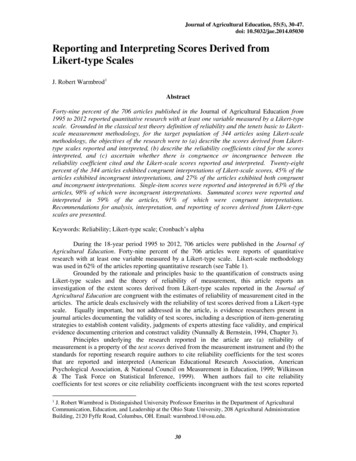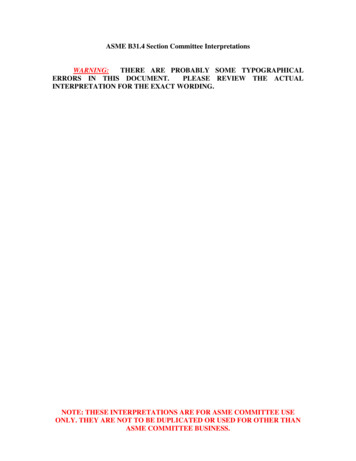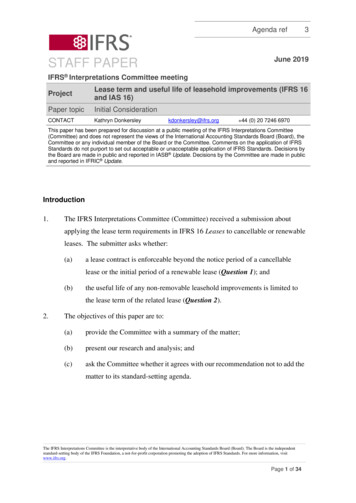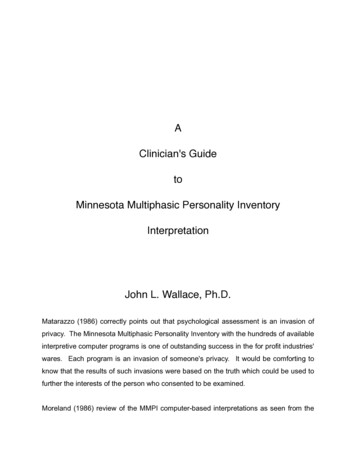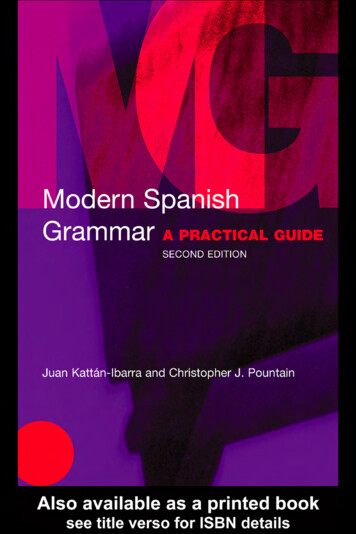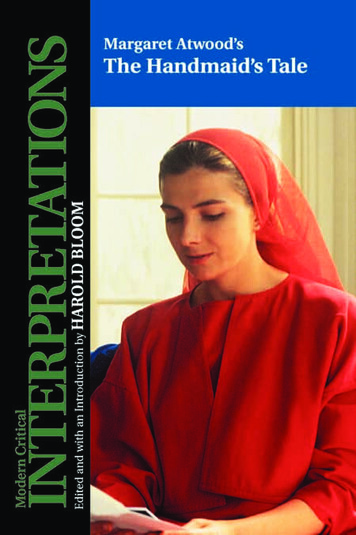
Transcription
Modern Critical InterpretationsAdventures of Huckleberry FinnAll Quiet on the Western FrontAnimal FarmBelovedBeowulfBilly Budd, Benito Cereno, Bartlebythe Scrivener, and Other TalesThe Bluest EyeThe Catcher in the RyeCatch-22The Color PurpleCrime and PunishmentThe CrucibleDaisy Miller, The Turn of the Screw,and Other TalesDavid CopperfieldDeath of a SalesmanThe Divine ComedyDon QuixoteDublinersEmmaFahrenheit 451A Farewell to ArmsFrankensteinThe General Prologue to theCanterbury TalesThe Glass MenagerieThe Grapes of WrathGreat ExpectationsThe Great GatsbyGulliver’s TravelsHamletThe Handmaid’s TaleHeart of DarknessI Know Why the Caged Bird SingsThe IliadThe Interpretation of DreamsInvisible ManJane EyreJulius CaesarKing LearLong Day’s Journey into NightLord JimLord of the FliesThe Lord of the RingsMacbethThe Merchant of VeniceThe MetamorphosisA Midsummer Night’s DreamMoby-DickMy ÁntoniaNative SonNight1984The OdysseyOedipus RexThe Old Man and the SeaOthelloParadise LostThe Pardoner’s TaleA Portrait of the Artist as a YoungManPride and PrejudiceThe Red Badge of CourageThe Rime of the Ancient MarinerRomeo and JulietThe Scarlet LetterA Scholarly Look at the Diary ofAnne FrankA Separate PeaceSlaughterhouse FiveSong of SolomonThe SonnetsThe Sound and the FuryThe StrangerA Streetcar Named DesireSulaThe Sun Also RisesA Tale of Two CitiesThe Tales of PoeThe TempestTess of the D’UrbervillesTheir Eyes Were Watching GodTo Kill a MockingbirdUlyssesWaiting for GodotWaldenThe Waste LandWuthering Heights
Modern Critical InterpretationsMargaret Atwood’sThe Handmaid’s TaleEdited and with an introduction byHarold BloomSterling Professor of the HumanitiesYale UniversityCHELSEA HOUSE PUBLISHERSPhiladelphia
2001 by Chelsea House Publishers,a subsidiary of Haights Cross Communications.Introduction 2000 by Harold Bloom.All rights reserved. No part of this publication may bereproduced or transmitted in any form or by any meanswithout the written permission of the publisher.Printed and bound in the United States of America10 9 8 7 6 5 4 3 2 The paper used in this publication meets the minimumrequirements of the American National Standard forPermanence of Paper for Printed Library Materials,Z39.48-1984Library of Congress Cataloging-in-Publication DataThe handmaid's tale / Harold Bloom, editor.p.cm. — (Modern critical interpretations)Includes bibliographical references(p. ) and index.ISBN 0-7910-5926-X (alk. paper)1. Atwood, Margaret Eleanor, 1939–. Handmaid's tale.2. Fantasy fiction, Canadian—History and criticism.I. Bloom, Harold. II. Series.PR9199.3.A8 H3165 2001813’.54—dc2100-065839Chelsea House Publishers1974 Sproul Road, Suite 400Broomall, PA 19008-0914The Chelsea House World Wide Web address ishttp://www.chelseahouse.comContributing Editor: Pamela LoosProduced by: Robert Gerson Publisher’s Services, Santa Barbara, CA
ContentsEditor’s NoteviiIntroduction 1Harold BloomMargaret Atwood’s The Handmaid’s Tale andthe Dystopian Tradition 3Amin MalakNature and Nurture in Dystopia: The Handmaid’s TaleRoberta Rubenstein11“Trust Me”: Reading the Romance Plot in Margaret Atwood’sThe Handmaid’s Tale 21Madonne MinerThe Misogyny of Patriarchal Culture in The Handmaid’s TaleJ. Brooks BousonOff the Path to Grandma’s House in The Handmaid’s TaleSharon Rose Wilson4163“The Missionary Position”: Feminism and Nationalism inMargaret Atwood’s The Handmaid’s Tale 81Sandra TomcThe Handmaid’s Tale: Dystopia and the Paradoxes of PowerGlenn Deer93
viCONTENTSMargaret Atwood’s The Handmaid’s Tale:Resistance through Narrating 113Hilde StaelsMargaret Atwood’s Modest Proposal: The Handmaid’s TaleKaren SteinWhat Is Real/Reel? Margaret Atwood’s “Rearrangement ofShapes on a Flat Surface,” or Narrative as Collage 141Marta DvorakThe Handmaid’s Tale: “Historical Notes” andDocumentary Subversion 155Dominick M. knowledgmentsIndex179177127
Editor’s NoteMy Introduction admires the literary skill and grim humor of TheHandmaid’s Tale.In the first two essays, Amin Malak and Roberta Rubenstein eachdiscuss The Handmaid’s Tale in the tradition of Dystopian fiction, afterwhich Madonne Miner reads the romance plot in the work and J. BrooksBouson comments on the patriarchal culture described in the book.Sharon Rose Wilson reads The Handmaid’s Tale as a fairy tale aboutfairy tales, and Sandra Tomc asserts that the novel fails as feminist doctrine.Glenn Deer emphasizes Atwood’s cunningly firm authorial control, afterwhich Atwoodian Gothic is seen by Hilde Staels as a turning-inside-out ofthe genre.Karen Stein explains how the epigraphs chosen as framing textsprepare the reader of The Handmaid’s Tale, and Marta Dvorak discussesAtwood’s use of visual images in the novel.In the volume’s final essay, Dominick M. Grace parses the “HistoricalNotes” that close The Handmaid’s Tale.vii
IntroductionLiterary survival, as such, was not my overt subject when I started out asa critic, nearly a half-century ago, but I have aged into an exegete who rarelymoves far from a concern with the question: Will it last? I have little regardfor the ideologies—feminist, Marxist, historicist, deconstructive—that nowtend to dominate both literary study and literary journalism. MargaretAtwood seems to me vastly superior as a critic of Atwood to the ideologuesshe attracts. My brief comments upon The Handmaid’s Tale will be indebtedto Atwood’s own published observations, and if I take any issue with her, it iswith diffidence, as she herself is an authentic authority upon literary survival.I first read The Handmaid’s Tale in 1986, shortly after it was published.Rereading it in 1999 remains a frightening experience, even if one lives inNew Haven and New York City, and not in Cambridge, Massachusetts,where the Handmaid Offred suffers the humiliations and torments afflictedupon much of womankind in the Fascist Republic of Gilead, which has takenover the Northeastern United States. Atwood, in describing her novel as adystopia, called it a cognate of A Clockwork Orange, Brave New World, andNineteen Eighty-Four. All of these, in 1999, are now period pieces. AnthonyBurgess’s A Clockwork Orange, despite its Joycean wordplay, is a much weakerbook than his memorable Inside Enderby, or his superb Nothing Like the Sun,persuasively spoken by Shakespeare-as-narrator. Aldous Huxley’s Brave NewWorld now seems genial but thin to the point of transparency, while GeorgeOrwell’s Nineteen Eighty-Four is just a rather bad fiction. ApproachingMillennium, these prophecies do not caution us. London’s thugs, like NewYork City’s, are not an enormous menace; Henry Ford does not seem to bethe God of the American Religion; Big Brother is not yet watching us, in ourrealm of virtual reality. But theocracy is a live menace: in Iran andAfghanistan, in the influence of the Christian Coalition upon the RepublicanParty, and on a much smaller scale, in the tyranny over English-speakinguniversities of our New Puritans, the academic feminists. The Handmaid’s1
2INTRODUCTIONTale, even if it did not have authentic aesthetic value (and it does), is not atall a period piece under our current circumstances. The Right-to-Lifedemagogues rant on, urging that the Constitution be amended, and whilecontemporary Mormonism maintains its repudiation of plural marriage, theOld Faith of Joseph Smith and Brigham Young is practiced by tens ofthousands of polygamists in Utah and adjacent states.Atwood says of The Handmaid’s Tale: “It is an imagined account of whathappens when not uncommon pronouncements about women are taken totheir logical conclusions.” Unless there is a Swiftian irony in that sentence,which I cannot quite hear, I am moved to murmur: just when and where, inthe world of Atwood and her readers, are those not uncommonpronouncements being made? There are a certain number of SouthernRepublican senators, and there is the leadership of the Southern Baptistconvention, and some other clerical Fascists, who perhaps would dare tomake such pronouncements, but “pronouncements” presumably have to bepublic, and in 1999 you don’t get very far by saying that a woman’s place isin the home. Doubtless we still have millions of men (and some women) whoin private endorse the Bismarckian formula for women: Kinder, Kirche, undKuchen, but they do not proclaim these sentiments to the voters.Atwood makes a less disputable point when she warns us about thehistory of American Puritanism, which is long and dangerous. Its tendenciesare always with us, and speculative fictions from Hawthorne to Atwoodlegitimately play upon its darkest aspects. The Handmaid’s Tale emerges fromthe strongest strain in Atwood’s imaginative sensibility, which is Gothic. AGothic dystopia is an oddly mixed genre, but Atwood makes it work. Offred’stone is consistent, cautious, and finally quite frightening. Atwood, in much,if not most, of her best poetry and prose, writes Northern Gothic in thetradition of the Brontës and of Mary Shelley. Though acclaimed by so manyPost-Modernist ideologues, Atwood is a kind of late Victorian novelist, andall the better for it. Her Gilead, at bottom, is a vampiric realm, a society sickwith blood. The Handmaid’s Tale is a brilliant Gothic achievement, and asalutary warning to keep our Puritanism mostly in the past.
AMIN MALAKMargaret Atwood’s The Handmaid’s Taleand the Dystopian TraditionIn The History of Sexuality, Michel Foucault impressively articulates thecomplex, formidably paradoxical relationship between sexuality and power,arguing how power dictates its law to sex:To deal with sex, power employs nothing more than a law ofprohibition. Its objective: that sex renounce itself. Its instrument:the threat of a punishment that is nothing other than thesuppression of sex. Renounce yourself or suffer the penalty ofbeing suppressed; do not appear if you do not want to disappear.Your existence will be maintained only at the cost of yournullification. Power constrains sex only through a taboo thatplays on the alternative between two nonexistences.Any reader of Margaret Atwood’s The Handmaid’s Tale needs to recallFoucault’s observation to contextualize the agonies of the narratorprotagonist, Offred, the victim of such a prohibition ordinance. By focusingthe narrative on one central character, Atwood reveals the indignity andterror of living under a futuristic regime controlled by Christianfundamentalists. The heroine is one of several “handmaids” who, because oftheir “viable ovaries,” are confined to a prison-like compound in order to beFrom Canadian Literature 112 (Spring 1987). 1996 by the University of British Columbia,Vancouver.3
4AMIN MALAKavailable for periodically programmed sexual intercourse with their“Commanders of the Faith.” This church-state regime, called Gilead,condones such an unorthodox practice out of necessity to overcome afertility crisis amongst the dwindling Caucasian population; as one of thenovel’s epigrams suggests, the polygamy of the Old Testament provides thesanction. True to the precedent set in Genesis, the Commander’s Wifearranges and supervises these sex sessions, in which the handmaid, desexedand dehumanized, is obliged to participate. The dire alternative for thehandmaid is banishment to the colonies, where women clean up radioactivewaste as slave labourers. The dictates of state policy in Gilead thus relegatesex to a saleable commodity exchanged for mere minimal survival.One of the novel’s successful aspects concerns the skilful portrayal of astate that in theory claims to be founded on Christian principles, yet inpractice miserably lacks spirituality and benevolence. The state in Gileadprescribes a pattern of life based on frugality, conformity, censorship,corruption, fear, and terror—in short, the usual terms of existence enforcedby totalitarian states, instance of which can be found in such dystopian worksas Zamyatin’s We, Huxley’s Brave New World, and Orwell’s 1984.In order to situate Atwood’s novel within the relevant context ofdystopia, I wish to articulate the salient dystopian features those three classicsreveal. The ensuing discussion will be an elaboration on Atwood’s renditionand redefinition of those features.1. Power, Totalitarianism, War:Dystopias essentially deal with power: power as the prohibition orperversion of human potential; power in its absolute form that, toquote from 1984, tolerates no flaws in the pattern it imposes onsociety. Dystopias thus show, in extreme terms, power functioningefficiently and mercilessly to its optimal totalitarian limit.Interestingly, war or foreign threats often loom in the background,providing the pretext to join external tension with internal terror.2. Dream-Nightmare: Fantasy: Reality:While dystopias may be fear-laden horror fiction (how the dreamturns into a nightmare), the emphasis of the work is not onhorror for its own sake, but on forewarning. Similarly, whiledystopias contain elements of the fantastic with a “touch ofexcess” carrying the narrative “one step [or more] beyond ourreality,” the aim is neither to distort reality beyond recognition,
Margaret Atwood’s The Handmaid’s Tale and the Dystopian Traditionnor to provide an escapist world for the reader, but “to allowcertain tendencies in modern society to spin forward without thebrake of sentiment and humaneness.”3. Binary Oppositions:Dystopias dramatize the eternal conflict between individualchoice and social necessity: the individual resenting thereplacement of his private volition by compulsory uniformitariandecisions made by an impersonal bureaucratic machinery;Zamyatin’s heroine poignantly sums up the conflict: “I do notwant anyone to want for me. I want to want for myself.” Thesphere of the binary opposition expands further to cover suchdialectical dualities as emotion and reason, creative imaginationand mathematical logic, intuition and science, tolerance andjudgment, kindness and cruelty, spirituality and materialism, loveand power, good and evil. The list can go on.4. Characterization:Dystopias often tend to offer two-dimensional character types;this tendency is possibly due to the pressure of the metaphoricaland ideological thrust of these works. Moreover, the nightmarishatmosphere of dystopias seems to preclude advancing positive,assertive characters that might provide the reader withconsoling hope. If such positive characters do exist, they usuallyprove miserably ineffectual when contending with ruthlessoverwhelming powers.5. Change and Time:Dystopian societies, consumed and controlled by regressivedogmas, appear constantly static: founded on coercion and rigidstructures, the system resists change and becomes arrested inparalysis. Such a static life “shorn of dynamic possibility,”becomes for the underprivileged members of society mediocre,monotonous and predictable: “a given and measured quantity thatcan neither rise to tragedy nor tumble to comedy.” Accordingly,dystopias are not associated with innovation and progress, but withfear of the future. They use, however, the present as an instructivereferent, offering a tacit alternative to the dystopian configuration.5
6AMIN MALAK6. Roman à These:To varying degrees, dystopias are quintessentially ideologicalnovels: they engage the reader in what Fredrick Jameson calls a“theoretical discourse,” whereby a range of thematic possibilitiesare posited and polarized against each other, yet the novelseventually reveal a definite philosophical and socio-politicaloutlook for which fiction proves to be a convenient medium.What distinguishes Atwood’s novel from those dystopian classics is itsobvious feminist focus. Gilead is openly misogynistic, in both its theocracyand practice. The state reduces the handmaids to the slavery status of beingmere “breeders” (a term bearing Swift’s satirical coinage):We are all for breeding purposes: We aren’t concubines, geishagirls, courtesans. On the contrary: everything possible has beendone to remove us from that category. There is supposed to benothing entertaining about us. . . . We are two-legged wombs,that’s all: sacred vessels, ambulatory chalices.In addition to the handmaids, Gilead offers its own state-sponsored brand ofprostitutes called the Jezebels: dolled-up women whose sole function is toentertain foreign delegations. In order to erase the former identity of thehandmaids, the state, moreover, cancels their original names and labels themaccording to the names of their Commanders, hence the names Offred,Ofglen, Ofwayne, Ofwarren. The women then become possessed articles,mere appendages to those men who exercise sexual mastery over them. Thehandmaid’s situation lucidly illustrates Simone de Beauvoir’s assertion in TheSecond Sex about man defining woman not as an autonomous being but assimply what he decrees to be relative to him: “For him she is sex—absolutesex, no less. She is defined and differentiated with reference to man and notwith reference to her; she is the incidental, as opposed to the essential. He isthe Subject, he is the Absolute—she is the Other.” This view of man’smarginalization of woman corroborates Foucault’s earlier observation aboutthe power-sex correlative; since man holds the sanctified reigns of power insociety, he rules, assigns roles, and decrees after social, religious, and cosmicconcepts convenient to his interests and desires.However, not all the female characters in Atwood’s novel aresympathetic, nor all the male ones demonic. The Aunts, a vicious élite ofcollaborators who conduct torture lectures, are among the church-state’sstaunchest supporters; these renegades turn into zealous converts,
Margaret Atwood’s The Handmaid’s Tale and the Dystopian Tradition7appropriating male values at the expense of their feminine instincts. One ofthem, Aunt Lydia, functions, ironically, as the spokesperson of antifeminism;she urges the handmaids to renounce themselves and become non-persons:“Modesty is invisibility, said Aunt Lydia. Never forget it. To be seen—to beseen—is to be—her voice trembled—penetrated. What you must be, girls, isimpenetrable. She called us girls.” On the other hand, Nick, theCommander’s chauffeur, is involved with the underground network, of menand women, that aims at rescuing women and conducting sabotage. Besides,Atwood’s heroine constantly yearns for her former marriage life with Luke,presently presumed dead. Accordingly, while Atwood poignantly condemnsthe misogynous mentality that can cause a heavy toll of human suffering, sherefrains from convicting a gender in its entirety as the perpetrator of thenightmare that is Gilead. Indeed, we witness very few of the male charactersacting with stark cruelty: the narrative reports most of the violent acts afterthe fact, sparing the reader gory scenes. Even the Commander appears morepathetic than sinister, baffled than manipulative, almost, at times, a Fool.Some may interpret Atwood’s position here as a non-feminist stance,approving of women’s status-quo. In a review for the Times LiterarySupplement, Lorna Sage describes The Handmaid’s Tale as Atwood’s“revisionist look at her more visionary self,” and as “a novel in praise of thepresent, for which, perhaps, you have to have the perspective of dystopia.” Itis really difficult to conceive Atwood’s praising the present, because, likeOrwell who in 1984 extrapolated specific ominous events and tendencies intwentieth-century politics, she tries to caution against right-wingfundamentalism, rigid dogmas, and misogynous theosophies that may becurrently gaining a deceptive popularity. The novel’s mimetic impulse thenaims at wresting an imperfect present from a horror-ridden future: it appealsfor vigilance, and an appreciation of the mature values of tolerance,compassion, and, above all, for women’s unique identity.The novel’s thematics operate by posting polarized extremes: adecadent present, which Aunt Lydia cynically describes as “a society dying. . . of too much choice,” and a totalitarian future that prohibits choice.Naturally, while rejecting the indulgent decadence and chaos of an anarchicsociety, the reader condemns the Gilead regime for its intolerant,prescriptive set of values that projects a tunnel vision on reality andeliminates human volition: “There is more than one kind of freedom, saidAunt Lydia. Freedom to and freedom from. In the days of anarchy, it wasfreedom to. Now you are being given freedom from. Don’t underrate it.” Asillustrated by the fears and agonies that Offred endures, when human beingsare not free to aspire toward whatever they wish, when choices become soseverely constrained that, to quote from Dostoyevsky’s The Possessed, “only
8AMIN MALAKthe necessary is necessary,” life turns into a painfully prolonged prison term.Interestingly, the victimization process does not involve Offred and thehandmaids alone, but extends to the oppressors as well. Everyone ruled bythe Gilead regime suffers the deprivation of having no choice, except whatthe church-state decrees; even the Commander is compelled to perform hissexual assignment with Offred as a matter of obligation: “This is norecreation, even for the Commander. This is serious business. TheCommander, too, is doing his duty.”Since the inhabitants of Gilead lead the precarious existence befittingvictims, most try in varied ways to cope, endure, and survive. This situationof being a victim and trying to survive dramatizes Atwood’s major thesis in hercritical work Survival: A Thematic Guide to Canadian Literature, in which shesuggests that Canada, metaphorically still a colony or an oppressed minority,is “a collective victim,” and that “the central symbol for Canada . . . isundoubtedly Survival, la Survivance.” Atwood, furthermore, enumerates whatshe labels “basic victim positions,” whereby a victim may choose any of fourpossible options, one of which is to acknowledge being a victim but refuse “toaccept the assumption that the role is inevitable.” This position fully explainsOffred’s role as the protagonist-narrator of The Handmaid’s Tale. Offred’sprogress as a maturing consciousness is indexed by an evolving awareness ofherself as a victimized woman, and then a gradual development towardinitiating risky but assertive schemes that break the slavery syndrome. Herdouble-crossing the Commander and his Wife, her choice to hazard a sexualaffair with Nick, and her association with the underground network, all pointto the shift from being a helpless victim to being a sly, subversive survivor.This impulse to survive, together with the occasional flashes of warmth andconcern among the handmaids, transmits reassuring signs of hope andhumanity in an otherwise chilling and depressing tale.What makes Atwood’s book such a moving tale is its clever technique inpresenting the heroine initially as a voice, almost like a sleepwalker conceivingdisjointed perceptions of its surroundings, as well as flashing reminiscencesabout a bygone life. As the scenes gather more details, the heroine’s voice issteadily and imperceptively, yet convincingly, transfigured into a fullroundedness, that parallels her maturing comprehension of what is happeningaround her. Thus the victim, manipulated and coerced, is metamorphosed intoa determined conniver who daringly violates the perverted canons of Gilead.Moreover, Atwood skilfully manipulates the time sequence between theheroine’s past (pre-Gilead life) and the present: those shifting reminiscencesoffer glimpses of a life, though not ideal, still filled with energy, creativity,humaneness and a sense of selfhood, a life that sharply contrasts with thealienation, slavery, and suffering under totalitarianism. By the end of the novel,
Margaret Atwood’s The Handmaid’s Tale and the Dystopian Tradition9the reader is effectively and conclusively shown how the misogynous regimefunctions on the basis of power, not choice; coercion, not volition; fear, notdesire. In other words, Atwood administers in doses the assaulting shocks toour sensibilities of a grim dystopian nightmare: initially, the narrative voice,distant and almost diffidently void of any emotions, emphasizes those aspectsof frugality and solemnity imposed by the state, then progressively tyranny andcorruption begin to unfold piecemeal. As the novel concludes, as the horrorreaches a climax, the narrative voice assumes a fully engaged emotional tonethat cleverly keeps us in suspense about the heroine’s fate. This method ofmeasured, well-punctuated revelations about Gilead connects symbolicallywith the novel’s central meaning: misogynous dogmas, no matter howseemingly innocuous and trustworthy they may appear at their initialconception, are bound, when allowed access to power, to reveal their ruthlesslytyrannical nature.Regardless of the novel’s dystopian essence, it nevertheless avoids beingsolemn; on the contrary, it sustains an ironic texture throughout. We do notfind too many frightening images that may compare with Oceana’s torturechambers: the few graphic horror scenes are crisply and snappily presented,sparing us a blood-curdling impact. (Some may criticize this restraint asundermining the novel’s integrity and emotional validity.) As in all dystopias,Atwood’s aim is to encourage the reader to adopt a rational stance that avoidstotal “suspension of disbelief.” This rational stance dislocates full emotionalinvolvement in order to create a Brechtian type of alienation that, in turn,generates an ironic charge. This rational stance too should not be total,because Atwood does want us to care sympathetically about her heroine’sfate; hence the emotional distance between reader and character must allowfor closeness, but up to a point. Furthermore, Atwood is equally keen onpreserving the ironic flair intact. No wonder then that she concludes TheHandmaid’s Tale with a climactic moment of irony: she exposes, in a hilariousepilogue, the absurdity and futility of certain academic writings that engagein dull, clinically sceptic analysis of irrelevancies and inanities, yet miss thevital issues. “If I may be permitted an editorial aside,” blabbers the keynotespeaker at a twenty-second century anthropological conference,allow me to say that in my opinion we must be cautious aboutpassing moral judgement upon the Gileadeans. Surely we havelearned by now that such judgements are of necessity culturespecific. Also, Gileadean society was under a good deal ofpressure, demographic and otherwise, and was subject to factorsfrom which we ourselves are happily more free. Our job is not tocensure but to understand. (Applause.)
10AMIN MALAKThe entire “Historical Notes” at the end of the novel represents a satire oncritics who spin out theories about literary or historical texts withoutgenuinely recognizing or experiencing the pathos expressed in them: theycircumvent issues, classify data, construct clever hypotheses garbed inritualistic, fashionable jargon, but no spirited illumination ever comes out oftheir endeavours. Atwood soberly demonstrates that when a critic or scholar(and by extension a reader) avoids, under the guise of scholarly objectivity,taking a moral or political stand about an issue of crucial magnitude such astotalitarianism, he or she will necessarily become an apologist for evil; moresignificantly, the applause the speaker receives gives us a further compellingglimpse into a distant future that still harbours strong misogynoustendencies.While the major dystopian features can clearly be located in TheHandmaid’s Tale, the novel offers two distinct additional features: feminismand irony. Dramatizing the interrelationship between power and sex, thebook’s feminism, despite condemning male misogynous mentality, upholdsand cherishes a man-woman axis; here, feminism functions inclusively ratherthan exclusively, poignantly rather than stridently, humanely rather thancynically. The novel’s ironic tone, on the other hand, betokens a confidentnarrative strategy that aims at treating a depressing material gently andgradually, yet firmly, openly, and conclusively, thus skilfully succeeding insecuring the reader’s sympathy and interest. The novel shows Atwood’sstrengths both as an engaging story-teller and a creator of a sympatheticheroine, and as an articulate crafts-woman of a theme that is both currentand controversial. As the novel signifies a landmark in the maturing processof Atwood’s creative career, her self-assured depiction of the grim dystopianworld gives an energetic and meaningful impetus to the genre.
R O B E R TA R U B E N S T E I NNature and Nurture in Dystopia:The Handmaid’s TaleOne might say that Margaret Atwood has always been concerned withissues of survival—first as a condition of Canadian experience and, morerecently, as a condition of female experience. In her latest fiction and poetry,she connects the personal and political dimensions of victimization andsurvival in explicitly female and feminist terms. Moreover, in the course ofher fiction the terms of survival have become increasingly problematic. Inher fablelike The Handmaid’s Tale, she stunningly extends, recasts, and invertstwo of the most persistent clusters of theme and imagery that originate in herearlier concern with survival: nature and nurture.As a number of her commentators have pointed out, Atwood uses theimagery of nature in her poetry and fiction in complex ways, delineating theterms of survival and growth as well as oppression and death. Concurrently,from the beginning of her fictional oeuvre in particular, nurture—I use theterm here as ironic shorthand for motherhood and procreation—is viewed inproblematic terms. In The Edible Woman, Marian MacAlpin’s female friendsdramatize extreme attitudes toward procreation as a “natural” function offemale identity: Ainsley is obsessed with becoming pregnant while Clara isvirtually engulfed by maternity. Marian views both women with scepticismand anxiety. A central problem for the narrator of Surfacing is the necessityto come to terms with her denied abortion; the somewhat ambiguous sign ofFrom Marga
Their Eyes Were Watching God To Kill a Mockingbird Ulysses Waiting for Godot Walden The Waste Land Wuthering Heights Modern Critical Interpretations. Edited and with an introduction by Harold Bloom Sterling Professor of the Humanit
